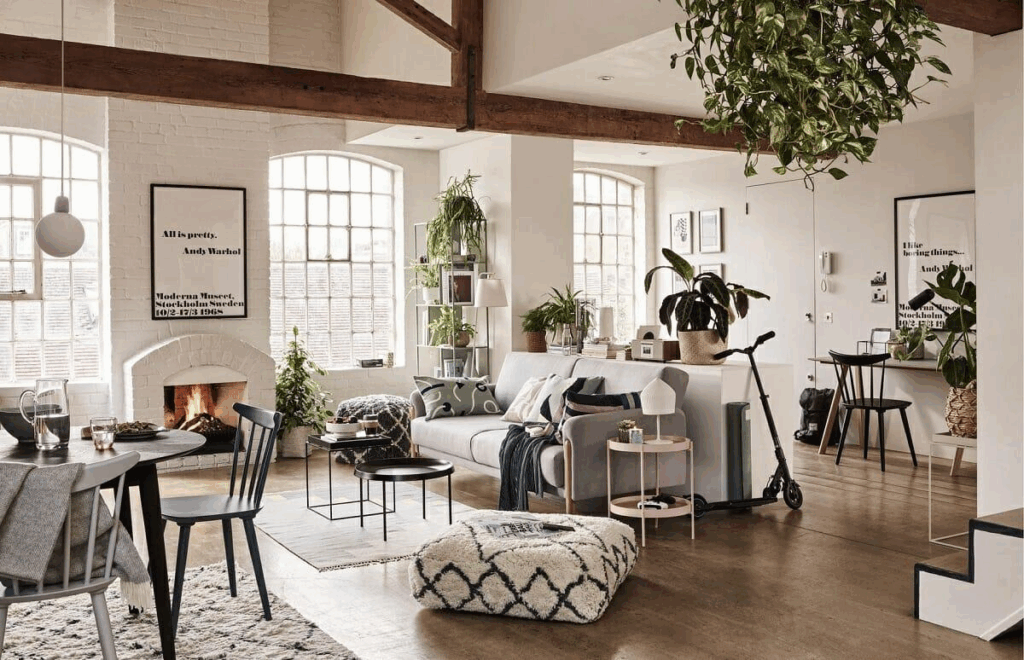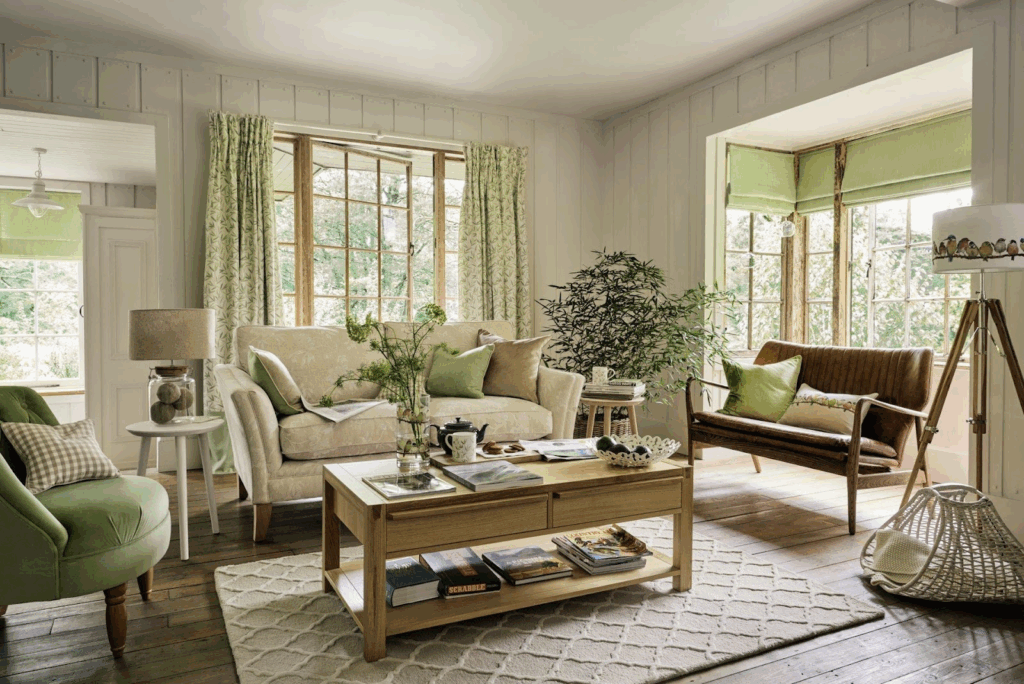Modern decor trends, particularly in the world of refined design, lean more and more toward a harmony of sophistication and sustainability. It may seem like an unusual pairing, yet it has become a mainstream trend we simply can’t ignore. We’re definitely not talking about heavy luxury here, since that’s usually all about how things look, with little thought given to how they’re actually made. Modern high-end interiors go beyond surface beauty, unfolding through balanced shapes, mindful design decisions, timeless elegance, and a genuine love for the environment you live in. This approach creates a space filled not only with style but also with meaning in every detail around you.
Eco-Luxury as a New Trend
Eco-luxury as a new direction in interior design has shaped its own philosophy, blending delicate taste, class, and the use of natural, non-toxic materials. For those inspired by this style, true home decor isn’t about flashy luxury, but about sensations—like the warmth of real wood, the elegance of stone, and the softness of textiles. What designers really want is to show off beauty that feels crafted by people, but still comes straight from nature. That’s the way a room gets its special vibe—calm and harmonious, but still with that touch of exclusivity and good taste.
Materials Commonly Used in Sustainable Home Decor
Within luxury, sustainability is no longer just about rare or precious materials—it’s also about where they come from, how they’re processed, their lasting quality, and the ethics behind them. Today, many high-end brands make it a priority to meet eco-quality standards, with a number of exclusive collections even crafted from recycled materials.
We can outline several categories:
- Leather
- Porcelain and china
- Glass
- Marble and natural stone
- Wood
- Rattan
- Metals.

Natural Stones
Stones like marble, granite, and onyx—as well as products made from them—are considered sustainable when responsibly sourced and minimally processed. Stone pieces last a really long time, can be restored if needed, and almost never wear out. That’s why in slow luxury, they’re seen as one of the smartest eco-friendly choices.
What also matters is uniqueness—every slab of stone carries a pattern of veins that can’t be repeated, turning each item into a genuine one-of-a-kind piece. Stone pieces go well with pretty much any style—modern luxury, classic, minimalism, art déco, contemporary, even hotel chic.
The most popular brands working with stone include:
- Salvatori (an Italian brand specializing in sustainable marble solutions)
- Baxter (furniture with marble elements)
- Antolini (extraordinary stone slabs from onyx to rare minerals)
- Fendi Casa
- Visionnaire
Precious and Semi-Precious Materials
Agate, quartz, malachite, mother-of-pearl, and even precious metals like gold, silver, and bronze can all be part of a conscious décor choice—when they come from ethical sourcing and careful processing, guided by standards such as the Responsible Jewellery Council. They are also incredibly durable, lasting for centuries in decor, and can be passed down through generations without ever losing their value. With the power to preserve their rich hues, textures, and natural luster, these materials often find new life as stunning art objects that elevate interior spaces. Stones and metals are super flexible. You’ll see them inlaid in furniture, lamps, accessories, and wall art, and even used in table settings—like agate coasters or fancy serving trays. Gold and platinum are frequently incorporated into glazes for porcelain decoration, whereas silver is commonly employed in cutlery and various table accessories. Precious and semi-precious objects are particularly suitable for use in Art deco, classic luxury, eclectic, maximalism, and modern glamour styles.
Here are some of the brands shaping this segment:
- Fornasetti (with its mineral and mother-of-pearl inlays)
- Agresti (safes and jewel boxes finished in malachite, agate, and other stones)
- De Gournay (known for decorative panels with mother-of-pearl)
- Christofle (with its handmade silver exclusives)
- Schiavon (décor items, accessories, and cutlery in precious metals).

Leather and Suede
Traditional leather has ecological drawbacks, but in luxury décor, the focus is on by-product leather from the food industry and vegetable-tanned leather that avoids the use of heavy chemicals.
New alternatives are also emerging: Piñatex made from pineapple fibers, mushroom-based mycelium leather, and apple leather—all considered part of the eco-luxury movement. When it comes to reliability and aesthetics, high-quality leather can last for decades, slowly developing a patina and unique character. Its evolving texture and tones, along with the natural aging of the surface, make every piece look alive and one-of-a-kind. Designers mostly use them for furniture upholstery, wall panels, accessories, and different details. In upscale interiors, leather and suede are often paired with brass, wood, and marble—think exclusive boxes, trays, baskets, or even complete bathroom sets.
Notable brands include:
- Giobagnara (hand-finished leather accessories and furniture).
- Pinetti (decorative items with sustainable tanning)
- Riviere (furniture and accessories combining leather with rattan, wood, and metal)
- Hermès Maison (testing eco-friendly materials, including Fine Mycelium)
- Stella McCartney Home (using alternatives to leather).
Textiles
The classic sustainable materials that have been part of daily life for centuries are linen, hemp, and organic cotton. Also included are silk under ethical production practices (peace silk), as well as natural wool and cashmere from controlled pasture management. These fabrics offer a range of tactile experiences—from the cool touch of linen to the softness of cashmere.
Fabrics frequently feature artisanal touches—hand embroidery, embellishments, or prints made with natural pigments, crafted into elegant table textiles, as well as refined pieces for the kitchen, bath, and bedroom. They’re also widely used for upholstery, wall panels, curtains, bedspreads, and many other décor elements that bring warmth and character into a home. With versatile hues and textures, these textiles slip seamlessly into any aesthetic. They shine particularly in Japandi, natural luxury, minimalism, boho-chic, and eco-modern spaces.
Among luxury leaders in sustainable textiles are:
- Loro Piana Interiors (setting the standard with responsibly sourced cashmere and wool)
- Pierre Frey (refined organic linen and cotton collections)
- Libeco (renowned for its exquisite Belgian linen)
- The Beanchy (linen homewear and home textiles)
- Society Limonta (where luxury meets environmentally conscious production).

Porcelain
Porcelain is crafted from natural minerals—kaolin, quartz, and feldspar—and when fired, it requires no toxic additives. It is a durable material that can be passed on as an heirloom and is also recyclable through modern technologies. In high-end decor, people really value handmade work and small collections—plates, vases, figurines, cups, and other pieces. Porcelain is highly durable, maintaining its whiteness, shine, and strength for decades.
Among the world’s porcelain leaders:
- Meissen (a German brand that’s been around since the 1700s)
- Haviland and Raynaud (French makers known for artistic collections)
- Hermès Maison (with its limited-edition tableware full of colorful patterns)
- Rosenthal and Vista Alegre ( contemporary design combined with a sustainable approach).
In Conclusion
Eco style isn’t just about looking nice. It’s about making conscious choices, where even the material itself plays a big role. The harmony of natural materials and refined design gives rise to a distinct aesthetic. In this light, decor becomes more than fashion—it becomes an investment in the enduring future of the home.
In fact, sustainable options go beyond the examples included in this overview. There are many more opportunities, and new materials and products continue to appear. Following these trends and applying them at home helps balance beauty with care for nature.
